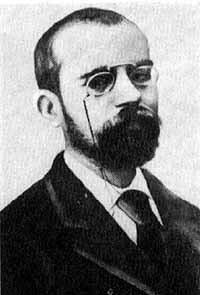Leopoldo Alas facts for kids
Leopoldo Alas y Ureña (born April 25, 1851 – died May 13, 1901) was a famous Spanish writer. He is better known by his pen name, Clarín. He was born in Zamora and later passed away in Oviedo. Clarín is known for his realistic stories about life in Spain.
Contents
Clarín's Early Life and Education
Clarín spent his childhood in León and Guadalajara. In 1865, he moved to Oviedo. There, he finished high school, which is called Bachillerato in Spain. After that, he began studying law.
Moving to Madrid and Becoming a Journalist
From 1871 to 1878, Clarín lived in Madrid. This is where he started his career as a journalist. He also completed his law degree. His final paper was titled El Derecho y la Moralidad, which means Law and Morality.
Teaching Career in Spain
Clarín taught in Zaragoza from 1882 to 1883. In 1883, he moved back to Oviedo. He became a teacher of Roman law at the university there.
Clarín's Most Famous Books
Clarín wrote many important books. His most famous novel is La Regenta. This book is very long and detailed. It is often compared to Madame Bovary by French writer Gustave Flaubert. Clarín was also inspired by a writing style called Naturalism. Another influence was Kraussism, a way of thinking that aimed to bring cultural and moral changes to Spain.
The Story of La Regenta
La Regenta is special because it has many characters. It also tells several smaller stories that happen around the main plot. The main character is a lady from a small city. Her story shows her downfall. She is caught between two very different men who want to marry her. One is the city's most handsome man. The other is the cathedral's priest. The way the priest is described is a very important part of the book.
Writing Style in La Regenta
To describe the city and its people, Clarín used special writing styles. One was the internal monologue. This is when the reader hears a character's thoughts directly. Another style was the free indirect style. This makes the story feel like it is told by the characters themselves, not just the narrator.
Su único hijo and Other Novels
In 1890, Clarín published another novel called Su único hijo (His Only Son). Most critics do not think it is as good as La Regenta. Su único hijo was meant to be the first of three books. However, the other two were never finished. Only a few notes and small parts of them exist. Su único hijo was Clarín's last long novel.
Other Writings by Clarín
Besides his novels, Clarín also wrote many short stories. He also wrote articles for newspapers and magazines. These articles showed his sharp observations about society.
Clarín's Place in Literature
Even today, Clarín is a very important figure in Spanish literature. He explored deep ideas in his writing. He often wrote about people searching for meaning in life. This mix of ideas has led to many different ways of understanding his works. La Regenta, in particular, has many different interpretations.
Works
- La Regenta (The Regent's Wife) (1884–85) [Novel]
- Su único hijo (His Only Son) (1890) [Novel]
- Doña Berta (1892)
- ¡Adiós, Cordera! (1892)
- Cuentos morales (Moral Stories) (1896)
- El gallo de Sócrates (Socrates' Rooster) (1900)
Essays
- Solos de Clarín (1881)
- La literatura en 1881 (1882)
- Sermón perdido (1885)
- Nueva campaña (1887)
- Ensayos y revistas (1892)
- Palique (1894)
Images for kids
-
"Clarín" on the 200 Pesetas 1980s banknote.
See also
 In Spanish: Leopoldo Alas, Clarín para niños
In Spanish: Leopoldo Alas, Clarín para niños



